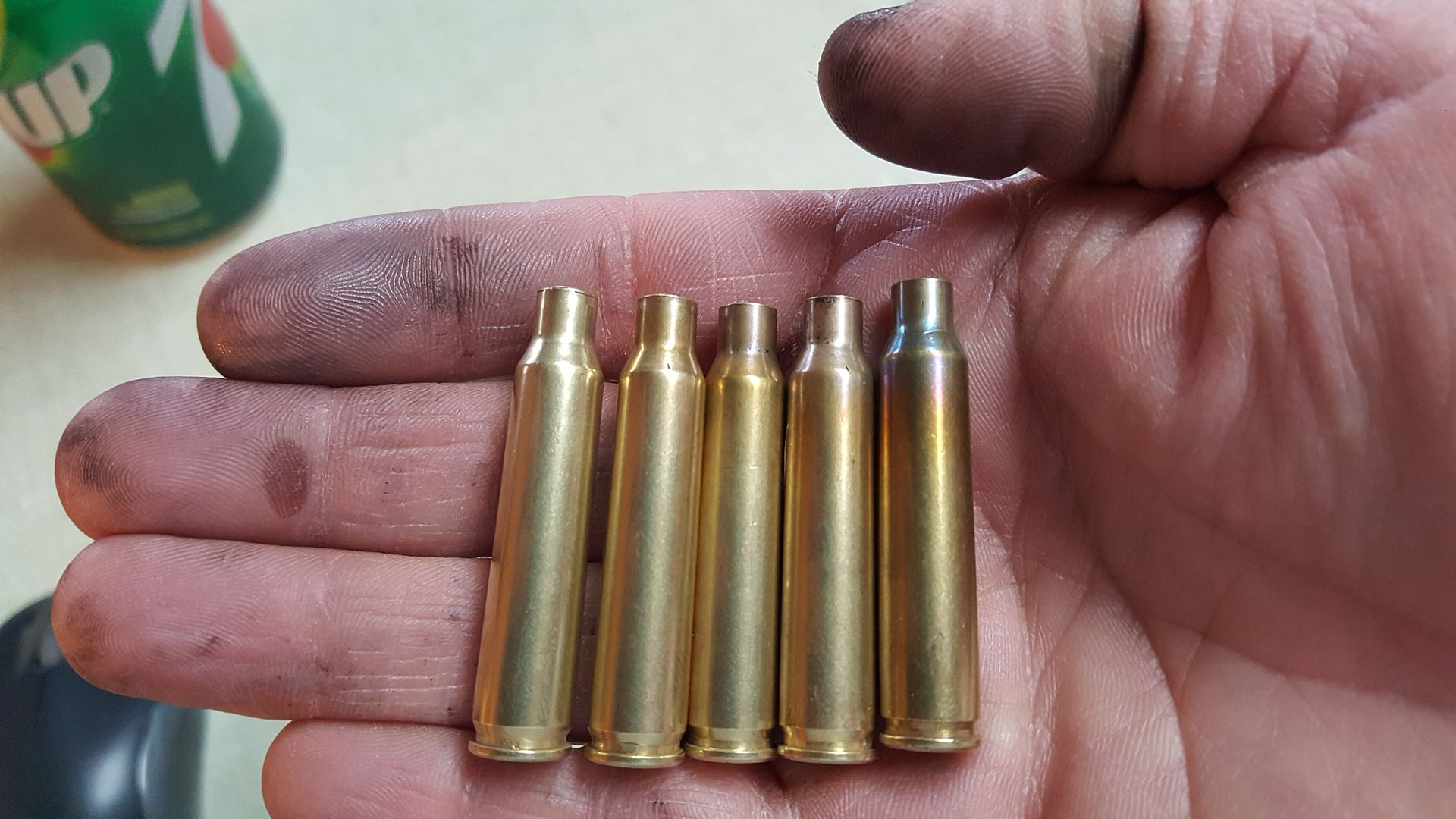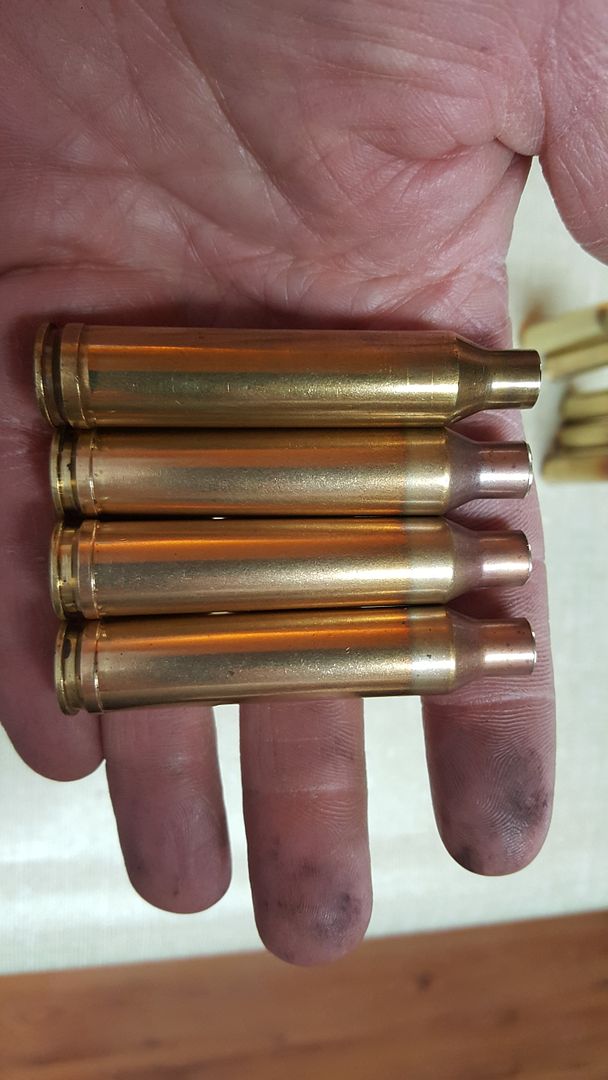-
Content Count
548 -
Joined
-
Last visited
-
Days Won
1
Posts posted by forepaw
-
-
Actually, that would be FRCP - fiberglass reinforced co-polymer. Just about indestructible unless you burn it.
forepaw
-
Looks like a spike bull, out on a long recon trip.
forepaw
-
OK, my apologies to forepaw first and foremost. A candle can definitely anneal brass. But.....I burned the crap out of my fingers while trying with a .223, .25-06, 7mmRM and .300RUM case.
It took about 30 seconds for the .223 to burn my fingers, with no annealing achieved. In a vice grip, I held it at the point of the flame for 1:00 with no color change visible. At 1:30, a very slight color change appeared on the neck (probably annealed at the neck only). At 2:00, neck and shoulder annealed.
For a 7mmRM case:
I could hold it for 55 seconds before it burned my fingers. No annealing visible. In a vice grip, @ 1:30, neck looks annealed. At 2:00, neck ad shoulder annealed like my torch does at 6 seconds.
I only had one .300RUM case that was not annealed, so I had to use the same case for all the tests. I could hold it for 1:15 before I burned my fingers. No visible color change or annealing. At 2:00, neck and shoulder annealed to my liking.
.25-06 burned my fingers at 50 seconds. No visible annealing. 1:30 showed signs of neck annealing. 2:00 shows neck/shoulders annealed like my others.
So a candle CAN anneal brass. I still stand by my response that I cannot hold case with my fingers and get proper annealing. And the efficiency is not there at all. I can do a case in an average of 6 seconds, vs.2 minutes with a candle.
Bottom to top: 0:30, 1:00, 1:30, 2:00, 2:30
Here are some 7RM cases. Top is 1:30 seconds over a candle. 3 on the bottom are 6 seconds in a MAPP gas torch.
Hey Lance, not a problem, appreciate the input. We all have gaps in our knowledge, and discussions and chit chat like this is how we learn new stuff. For the record, I am not an expert or advanced shooter or handloader, and certainly am not a metallurgist. I was just trying to help the OP with some basic info without overwhelming him with technical jargon. Hopefully he will stay involved and keep tapping into the knowledge base on these forums.
By the way, I didn't go into detail on the candle method, as I did not save the full write-up. (I know, I goofed.) Also the original source can offer a much better explanation if you would care to get in touch. This would be a guy named John Barsness. He IS an advanced shooter and handloader (and writer) and has provided some tips which have helped me a lot. He writes for Rifle and Handloader magazines, and I expect Wolfe Publishing Co. could provide contact info. Or you could just go to the forums on www.24hourcampfire.com and post a question on "Ask the Gunwriters". Hope that helps, and thanks for your useful photos and comments!
forepaw
-
Thanx forepaw! So it's not abnormal or bad?
It is perfectly normal, and you should be good for a number of reloads as long as you keep charges below max. according to your manual. I would recommend annealing your cases after every 4th or 5th firing. To do this, get a household candle and a damp paper towel, hold the case in your fingers (by the base or rim) and heat the neck in the flame. When it becomes too hot to hold any longer, pull it off the flame, and quench with the wet paper towel. That's it. Be sure and check your case length, and trim any time they go beyond SAAMI spec. In fact, by the 3rd firing you probably need to trim, unless you have a minimum dimension chamber, and have been using mild loads.
The other posters have given some good info, and it would be a smart move to research your manual or the internet for what the different terms mean, and how to "read" your brass. Some of the clues can be pretty subtle, and you are doing the right thing by watching for pressure and failure signs.
As long as the fired case chambers easily in your rifle, and you set your die up according to the instructions, you should be fine. Don't forget to check for case neck splitting, it is common unless you are using premium brass. Neck splits go in the recycle bin, don't try to trim them.
Hope that helps.
forepaw
-
I'm still new to reloading and have no idea what could be causing this on my brass.byou can see the color change and there is a little bit of a raised ring too. This case is on its 3rd firing. Hopefully you can see it in the pic
Normal compression during full length sizing. This is where the die body can't size any further because it is stopped by the lock ring clearance setpoint. If you sized further toward the shellholder, you might collapse the case.
forepaw
-
Let me know what you have in 270 and up?
Thanks,
Don
480-201-6570
Good choice. That's a lot of rifle for the money. You have a choice of the T3 Hunter (Walnut), T3 Lite (Tupperware) or the Ultra-lite (fluted barrel). I have a T3 Lite and it is almost too light for accurate shooting from field positions. Nice to carry though.
forepaw
-
PM sent.
forepaw
-
Really pisses me off for someone to say I can't do what I know I can. heck, I useta shoot 140's outta my .270 at 3200 but I got tired of flat primers so I backed off. Winchester and remington both offered 3200 fps factory loads for the .264 at one time. I know guys that were blending powders back in the 60's and we're doing some crazy things with it. I've stacked powders before with some amazing results, but it's sorta spooky. Back in the "old days" before range finders, the best way to stretch out there and hit something was to increase velocity and straighten out the bullet arc a little. With the tech improvements in the last 20 years, that's pretty much useless now, but I still like velocity. Mainly because I get a kick outta making running shots. And I think the .264 is a great option for a lotta stuff. Use what you want md33. Just trying to give you an option. Lark
That's some scary stuff right there.
forepaw
-
I was wondering what kind of water purification you guys use and would recommend?
It mostly depends on the source you are using. If it is a protected spring, within a predominantly backcountry or wilderness area, I would just use the bottled iodine tabs available at REI or Sportsman's. You could also use fresh household bleach, at the dosage of 8 drops per gallon of water. I almost always have an eyedropper with me for this purpose. If your source is surface water, or in an area with known recreational use upstream, you probably should filter first, then disinfect. There are a number of good backpacking filters such as the Katadyne, PUR (Hiker, Scout) and others. You can google this info, or go right to REI for more details on their products. If you are someplace with really roily, turbid water, you will need not only filtration and disinfection, but also some sort of pretreatment. Sometimes filtering through fine mesh (pantyhose) or even a clean t-shirt will remove enough sediment for you to treat and drink the water. If it is really bad, use about a tablespoon full of alum (aluminum sulfate, powdered) per gallon. Colorado river water for example, won't settle by gravity enough to produce much clarification. Even letting it sit overnight will not clear it up. It will settle out some, but not all of the particulates. You need to hit it with a metallic salt such as alum (or ferric chloride) to really settle the water. Decant the clear water into another container for treatment.
I would not recommend drinking any backcountry water without treatment.
forepaw
-
 2
2
-
-
I take it the nylon brush is used instead of a brass bristle brush due to SC copper remover? I generally use SC bore cleaner (#4) only with a brass brush, as follows:
3 wet patches; wet bore brush, about 2x for each round fired; dry patch; wet patch x2 then wait; dry patch or two, then wipe out chamber and done. If it is extra dirty, I will make an extra pass with brush, or else use JB Bore Paste.
I know how aggravating this can be. You have got yourself a real mystery, but something is behind it. Let us know what you find out. I have found Barnes bullets to be pretty consistent, both in handloads and Fed. Premium factory.
I only know of one smith who has a borescope available (no charge when I used his service) but he is in Lake Havasu City. I am sure there are others, but a close inspection would probably be useful in ruling out bore wear or some irregularity that is not apparent. It would take some abuse to eat up a barrel in 350 rds. but I expect it is possible.
forepaw
-
Sounds like you need to find a good smith and have them re-crown your barrel. Throat wear would generally not decrease accuracy as dramatically as what you are seeing. Besides, your total round count is not high, so it makes me think something has damaged the crown.
forepaw
-
I don't own or shoot one, but have heard good things about them. I have pretty much been a Bowtech user, and recently got an Athens Accomplice set up, and it shoots very well.
I would not have any problem with a Prime, other than not needing one right now, and difficulty finding lefty bows.
forepaw
-
I tend to agree. As I mentioned, MOA turrets are probably the most flexible, provided you do most of your zeroing and hunting under pretty much the same conditions. One friend (who is a more advanced shooter than me) keeps 2 cds dials cut for the same rifle, same load but different conditions - one is for 85 deg. F. at 2000' elev. (where he lives and practices) and the other is 35 deg. F. at 9000' elev. (where he hunts elk in CO). All I know is, it seems to work. The guy kills elk at long range pretty consistently.
Cds dials don't stick out like turrets, and they don't change position when being pushed or pulled into a case or scabbard (generally speaking), and you don't have to worry about whether or not your return to zero is the same every time. If your target changes position after you shoot, you don't have to range, pull out your folded sheet of data and reset your turret. You just range, reach up and twist to the new yardage. Better if you're in the middle of a case of buck fever!
If you use a smart phone with ballistic app. and wind meter, then that is a different story, however, the time required to become really proficient goes up substantially. Where I live, there is some sort of long range rifle competition almost every weekend. What I have noticed is a lot of people have electronic devices and gizmos, but they don't seem to hit targets with any more regularity than the more traditional shooters. And the guys who win the matches are usually old codgers with thick glasses and a printout with their load data. The main difference is they can read the wind (or have a spotter who can).
forepaw
-
 1
1
-
-
My experience is limited to one cds scope with dials cut for 2 loads. You would probably have more flexibility with standard MOA turrets. The cds forces you to get pretty fussy with load development. You are locked in to performance under one set of conditions, which in reality, probably covers quite a bit of changes in elevation and temp. but it won't be exact. You do need good chron. data. I like the zero-stop feature, and have not had any problem with the elev. turret moving.
Sometimes the tics don't line up exactly between the turret and base. This liked to drove me crazy at first. Also, you may not have an exact and consistent number of tics between main yardage settings, in other words, between one setting your increments may end up being an odd number of yards, 12, or 14 or whatever, instead of 4 ea. at 25, or 5 ea. at 20. These are minor issues unless you are shooting clay birds at 500 yds. Overall the system works well, and is more or less foolproof once you get used to it. I do not dial for windage. That is way too complicated and time consuming for hunting, unless you know (or have someone with you who knows) how to read mirage. If you get some trigger time at different yardages in say a 10 mph full-value wind, you will get an idea how much your bullet is going to move. For example, with my main load, I know that a 10 mph wind will move my poi 18" at 600 yds. (This does not mean it will be 9" at 300 yds.) You will have to shoot through the different conditions and see what the changes are, and then memorize them or print and paste them onto your stock if you want to use the hold-off method.
You may do well to research the Leupold custom shop options. At one time, you could get parallax collimated to your desired yardage for only $10. Believe this requires purchase through the custom shop - not a problem. I had them set my parallax at 400 yds. and it is much more useful than the standard setting of 150 yds.
forepaw
-
www.24hourcampfire.com
-
10-4, can see cross-bolt safety at the front of the trigger guard. I was referring to the fitting or hardware at the front of the receiver on the left side - right behind the magazine. Just curious, thought it might be similar to Browning shotguns.
Thanks.
forepaw
-
Is that a magazine cutoff on the left front of the receiver?
forepaw
-
Also consider that your house might get tweaked a little someday - however slightly. It doesn't take much to shift weight-bearing walls if you have some subsidence or seismic activity. Then gravity can get in its dirty licks. A structural engineer could tell you in about 15 min. might cost $75 - $125. Maybe nothing if it is a quick calc. or something they have done before.
forepaw
-
First, try cleaning the bore real well. Use some JB Borepaste. Then find someone who you know is a good shot, have them fire one round to foul, and let them shoot a couple of no-wind 3-shot groups. It sounds to me like you might be doing a pretty respectable job with your loads already if your rifle is strictly factory. The '06 is not considered a tackdriver compared to some rounds (though it can be very accurate), and out of a light rifle, I would be happy with occasional 1" groups, and 1 1/2" overall. It is not fussy to load for, and you should be able to find a load by picking one from about any manual. Decide what bullet you prefer and build your load around that.
You might try switching primers, and also try another lot of IMR 4350. Make sure the guard and scope mount screws are torqued to factory specs. and there are no places rubbing the barrel along the barrel channel. Finally, assuming you have a decent trigger and bedding, have a gunsmith re-crown your barrel.
forepaw
-
It's great to find a high-grade lefty bow. Just the right weight and draw length for all-around use. Hoyts are famous for durability, and being able to swap cams and limbs. Somebody needs to latch on to this!
forepaw
-
Make sure you brush the inside of the case mouths. A very small amount of lube on your brush, or powdered dry lube will do it. If the case mouths are dry, you risk overstretching your brass. Plus, it is really annoying to keep dragging your brass over a dry expander ball.
Regarding the dented shoulders, ditto on the comments from the other posters. Also, make sure the vent hole in your sizing die is open. You can use a paper clip or safety pin to check. This is where the trapped air is allowed to bleed out to prevent denting your brass.
forepaw
-
You mean East Clear Cr.?
forepaw
-
It is highly variable - depends on powder (double base, single base, composition, additives, coating, etc.) , but if you keep it closed, and stored in a dark, climate controlled space, an 8# keg could be good for 8 - 10 years. I think I have kept small quantities longer than that, but did not use them.
If you ever open it and do not detect an ether smell, it has probably had it, and would be best to dispose of it. It is basically fertilizer at that point. If you match the amount of shooting you do, to the amount of stored powder on hand, you should cycle through it every 2 - 3 yrs. It can be tempting to stock up when you find a good buy somewhere, but remember it is semi-perishable, and you might end up selling at a loss just to unload it. Ask me how I know.
forepaw
-
tomkat12, it is encouraging that you thought enough of the Tikka to at least salvage the action. They have some drawbacks, and aren't for everyone.
Just curious, in general what did you end up with in terms of performance, and how much of a net improvement did you see over and above what could be done with an out of the box Tikka in terms of high quality bolt-on accessories (mount, rings, scope, trigger cerakote, bipod, etc.), tuning, handloading, and practicing?
I agree the limitations of available calibers are a continuing problem with Tikkas.
Thanks.
forepaw





Tikka T3 Factory Stock
in Classified Ads
Posted · Report reply
I guess since I paid full price for my Tikka then it's ok for me to order a McMillan lol! Let us know how the Boyd's laminate works out, they have some nice stuff at decent prices.
What lefty Tikkas do you have? Got pics?
forepaw